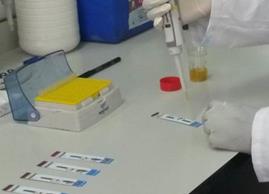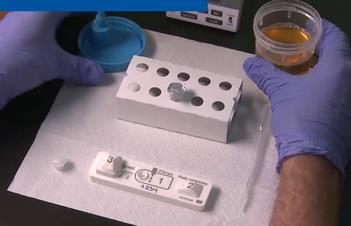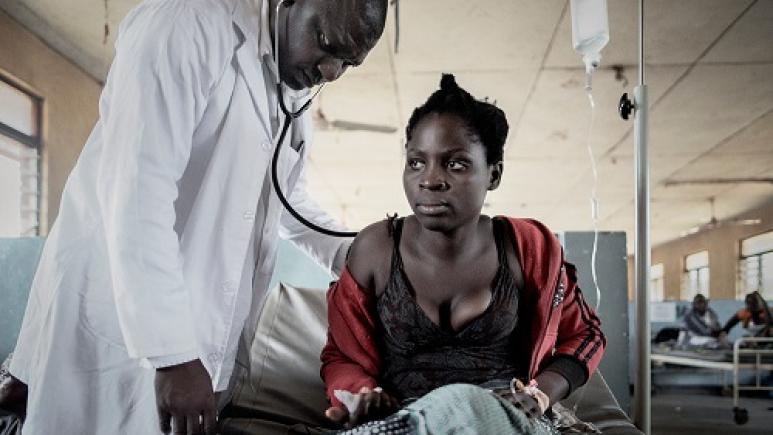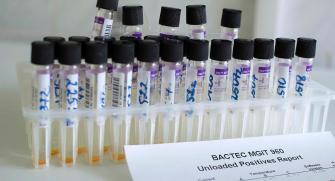Toward a simpler diagnosis of tuberculosis in people living with HIV
Tuberculosis is the leading cause of death from infectious disease in the world. According to the WHO, each year 10 million people are diagnosed and 1.5 million die. A quarter of the new cases occur on the African continent, where tuberculosis is spreading rapidly because of the high proportion of people living with HIV.
Tuberculosis and HIV: a pernicious duo
Being infected with HIV and sick with TB sounds like a double whammy. HIV lowers the immune system and "opens the door" to other infections. People infected with HIV are up to 30 times more likely to develop TB, with 250,000 people worldwide reported to have died of HIV-associated TB in 2018.
"Unfortunately too many people don't know they are co-infected," says Helena Huerga, an epidemiologist at Epicentre and manager of TB research projects.
And without diagnosis, there is no treatment. Hence the urgent need to develop reliable and accessible tests for this population.
Diagnosing tuberculosis: a challenge
"Automated molecular diagnostics such as Xpert MTB/RIF show good sensitivity and specificity," says Helena Huerga, "but because of their cost, the need for electricity, and the laboratory infrastructure required, they are not widely available in resource-limited settings, where diagnosis still often relies on sputum analysis by microscopy. "

Therefore, the development and evaluation of more user-friendly tests is a challenge to improve patient management and provide treatment more quickly. The latest developments in this field consist of analyzing urine samples for an antigen, an indicator of the presence of the mycobacterium that causes tuberculosis. Urine sampling is also an alternative for very sick HIV-positive people who are sometimes unable to produce sputum. “We first evaluated the AlereLAM test," says Helena Huerga. Despite the limited sensitivity of this test, its use allows the initiation of anti-tuberculosis treatment immediately after a positive result and reduces mortality in hospitalized patients." Today, AlereLAM is recommended for the diagnosis of tuberculosis in HIV-positive people with signs or symptoms of tuberculosis.
FujiLAM: A more sensitive test under evaluation
In the meantime, other tests have been developed that are apparently more sensitive. Epicentre has launched a study to evaluate the FujiLAM test, which can detect antigen concentrations 30 times lower than those of AlereLAM. “A first study using frozen urine samples showed a sensitivity with FujiLAM of 70% in HIV-positive hospitalized patients," says the epidemiologist. In this study, the sensitivity of FujiLAM was 28% higher than that of AlereLAM.” These initial results suggest a possible improvement in the diagnosis of tuberculosis in HIV-positive patients.

Funded by the French National Agency for Research on AIDS and Viral Hepatitis (ANRS) and Médecins Sans Frontières, the study included two types of outpatient populations:
- HIV-positive patients with TB symptoms
- HIV-positive patients with advanced HIV disease and no signs or symptoms of TB.
Approximately 1500 patients were recruited from four sites with high HIV and TB prevalence:
- Mbarara Regional Referral Hospital in Uganda,
- Homa Bay District Hospital in Kenya,
- Alto Maé Health Center in Mozambique,
- Eshowe Gateway Clinic (EGC) and District Hospital in Eshowe, KwaZulu-Natal, South Africa.
“First results show a sensitivity of 60% with FujiLAM in HIV-positive patients with a confirmed diagnosis of tuberculosis, compared with 40% with AlereLAM," explains the epidemiologist. The sensitivity of FujiLAM is superior to that of AlereLAM.” These initial results suggest a possible improvement in the diagnosis of tuberculosis in HIV-positive patients.
Another part of the study focused on its feasibility and acceptability to the laboratory technicians, nurses, clinicians, and community health workers who perform it, as well as to patients. The implementation of the FujiLAM test is described by users as feasible within the existing infrastructure and the test is well accepted. In terms of patient perception of the FujiLAM test, the results of the study show that urine collection is well tolerated and preferred to sputum collection by patients.
The "point-of-care" FujiLAM test has thus been able to detect a considerable proportion of patients with tuberculosis while being well accepted by the staff performing the test and the patients. Its implementation should therefore be seen as a step forward in the diagnosis of tuberculosis.
LEARN MORE ABOUT THE Diagnostic performance and feasibility of FujiLAM
Better diagnosis for better treatment
Diagnosis paves the way for treatment, without which the outcome can quickly be fatal. It generally consists of a combination of 4 antibiotics for 6 months. However, this treatment remains long and more and more resistant forms are emerging. Several large-scale projects involving Epicentre, Médecins Sans Frontières and other partners are underway to develop new therapeutic strategies to treat tuberculosis.









